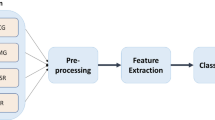Abstract
This paper presents the correlation between psychological and physiological acoustics for automobile sounds. The purpose of this paper is to evaluate the quality of the interior sound in passenger cars based on electroencephalogram (EEG). Previous objective evaluation method of sound quality involved the use of sound metrics based on psychological acoustics. The proposed method employed not only the psychological but also the physiological acoustics. In this work, the sounds of seven premium passenger cars were recorded, and they were evaluated subjectively by 33 people. The correlation between the subjective rating and the sound metrics was calculated based on psychological acoustics. Finally, the correlation between the subjective rating and the brain EEG was also calculated. Based on these results, a new evaluation system for evaluating the quality of the interior sounds of passenger cars was developed based on bio-signals.
Similar content being viewed by others
References
S. K. Lee and H. C. Chae, The application of artificial neural networks to the characterization of interior noise booming in passenger cars, Proceeding of the Institute of Mechanical Engineers Part D, Journal of Automobile Engineering, 218(1) (2004) 33–42.
S. K. Lee, B. S. Kim and D. C. Park, Objective evaluation of the rumbling sound in passenger cars based on an artificial neural network, Proceeding of the Institute of Mechanical Engineers Part D, Journal of Automobile Engineering, 219(4) (2005) 457–469.
S. K. Lee, Objective evaluation of interior sound quality in passenger cars during acceleration, Journal of Sound and Vibration, 310(1) (2008) 149–168.
S. K. Lee, H. W. Kim and E. W. Na, Improvement of impact noise in a passenger car utilizing sound metric based on wavelet transform, Journal of Sound and Vibration, 329(1) (2010) 3606–3619.
M. F. Bear, B. W Connors and M. A. Paradiso, Neoroscience: Exploring the Brain, Lippincott Williams & Wilkins, Philadelphia, PA (2007).
T. Shinji, I. Tomohiko, M. Nobuki and K. Hiroaki, Biosignal measurement and processing. relation between biological signals and subjective estimation while humans listen to sounds, Transactions of the Institute of Electrical Engineers of Japan, 122-C(9) (2002) 1632–1638.
E. Basar, C. Basar-Eroglu, S. Karakas and M. Schürmann, Oscillatory brain theory: A new trend in neuroscience, IEEE Engineering in Medicine and Biology, 18 (1999) 56–66.
H. Berger, Über das Elektrenkephalogramm des Menschen, Archiv für Psychiatrie und Nervenkrankheiten, 87 (1929) 527–570.
E. Adrian, Olfactory reactions in the brain of the hedgehog, Journal of Physiology (London), 100 (1942) 459–473.
Author information
Authors and Affiliations
Corresponding author
Additional information
Recommended by Associate Editor Cheolung Cheong
Young Joon Lee is currently a Ph.D. student in the Department of Mechanical Engineering, Inha University, Inchon, Korea. His studies involve the application of signal processing to acoustics and vibration in automotive sound quality.
Tae Jin Shin is currently a Ph.D. student in the Department of Mechanical Engineering, Inha University, Inchon, Korea. His studies involve sound quality analysis.
Sang-Kwon Lee was born in Pusan, Korea, in 1959. He received the B.S. degree in mechanical engineering from Pusan National University, Pusan, Korea, and the Ph.D. degree in signal processing from the Institute of Sound and Vibration Research, University of Southampton, U.K., in 1998. He was with the Hyundai Motor Co. and the Renault-Samsung Motor Company in Korea for 11 years, where he gained experience in automotive noise control. Since 1999, he has been with Inha University, Inchon, Korea, where he became a Professor and continued his research on acoustics and vibration signal processing in the Department of Mechanical Engineering.
Rights and permissions
About this article
Cite this article
Lee, Y.J., Shin, T.J. & Lee, S.K. Sound quality analysis of a passenger car based on electroencephalography. J Mech Sci Technol 27, 319–325 (2013). https://doi.org/10.1007/s12206-012-1248-z
Received:
Revised:
Accepted:
Published:
Issue Date:
DOI: https://doi.org/10.1007/s12206-012-1248-z




